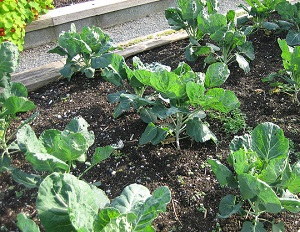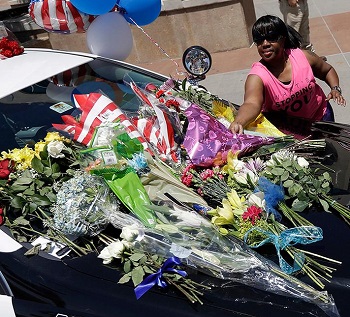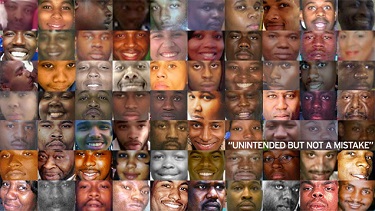Endorsing “A Vision for Black Lives”
UU Class Conversations has endorsed “A Vision for Black Lives,” a carefully crafted policy platform that has been drafted by the Movement for Black Lives. The Movement is a collective of more than 50 organizations representing thousands of Black people from across the country that have come together to articulate a common vision and agenda.
Sharing a Vision
“A Vision for Black Lives” lays out 30+ policy recommendations under six demands. The platform was created in response to the sustained and increasingly visible violence against Black communities in the U.S. and globally.
The Movement for Black Lives Policy Table engaged in a year-long process of convening local and national groups to create the platform. In addition, the coalition solicited feedback from hundreds of people through surveys and national calls as well as from members of coalition organizations.
Shared Policy Priorities
The Movement for Black Live engaged dozens of other organizations, researchers, and individuals for their insights and expertise to begin developing a framework for shared policy priorities. While the platform does not include every policy Black people should be working on, it elevates those for which there was shared energy and action in this political moment.
We encourage you to join UU Class Conversations, and endorse this historic document. And work on the parts of the platform that you and/or your organization most strongly agree with. Read the policies, share them with your community, discuss the points you disagree on, and plan actions around the pieces you support.
Save the Tree, but What About We?

By Bethany Ramirez
If all politics are local, there is currently a dust up about renovations to the park across the street from me. Plans include the removal of a tree that interferes with the community garden area. But the renovations were halted before they began because of a movement to save the tree.
And recently there have been some members of the community (certainly not most) who have made dismissive comments about the community garden in a way that makes me want to unpack some classism.
When Your Justice Collides with Ours
When we first came to look at this apartment, we were quite excited to discover that the community gardens were so close. We were even more excited to learn that there was already a fenced-in garden space in our yard, so we did not need to worry about the waiting list for a community plot. It had not been used for several years, so we invested a lot of time and money into cleaning out concrete and patching the fence.
However, our garden is struggling. Since the garden was last used, one of the trees has grown to cast shade over most of the space. And since the landlord does not want tenants wasting water, there is no water hooked up to the hose – a problem when we are approaching drought conditions.
In order for us to garden next year, either the landlord has to fix both of these problems, or we will have to use the community garden across the street. We rent. We cannot just move the garden location to somewhere else in our yard. Many neighbors don’t have space to garden at all. This is what community gardens are for. In fact, we are sharing our garden with friends from the next town who are on a waiting list for a community garden where it could take them years to get a plot.
There are class issues in the dismissive comments people have made about the community gardens. There are class issues in being able to afford to garden at all in the first place. And there are class issues in claiming a tree is more important than community gardens that have nowhere else to go. We talk a lot about how the poor can’t afford fresh produce, and we’re not letting them grow their own, either.
Bethany lives in Arlington, Mass., which, as of 2011, is 40% renter-occupied (source: http://arlingtonma.gov/home/showdocument?id=28425).
It Will Take Courage to End This Nightmare
by Denise Moorehead
As I listened to the news this week – first about still more unarmed black men dying at the hands of the police and then yesterday morning about 12 Dallas policemen being gunned down – I got angrier and angrier at the hypocrisy of the newscasters and pundits. To avoid being called cop haters or Black Lives Matter apologists, everyone spoke of their shock at what happened in Louisiana and Minnesota and then said, “but how could what happened in Dallas, happen?”
It is ridiculous, even offensive, to pretend that we don’t see the connection between the seemingly unending string of police shootings of black men as well as women and children – some found to be murders – and the very cruel actions of the Dallas shooter. The Dallas shooter left five families without fathers, husbands, sons, brothers, uncles and nephews. I feel truly, truly sorry for their families. It is not fair at all that these officers were randomly chosen to die in this revenge killing.
 To refuse to acknowledge the connection, however, is part of the reason that the gunman did what he did. He believed that no one in power is doing anything to stop the random killing of black men across the United States.
To refuse to acknowledge the connection, however, is part of the reason that the gunman did what he did. He believed that no one in power is doing anything to stop the random killing of black men across the United States.
I can never condone what the Dallas shooter did. I have a husband, father and nephew. But I do not pretend that I do not know why he believed his actions were rational. A 2015 study by the Washington Post found that unarmed black men were seven times more likely than whites to die by police gunfire. It is not getting better.
When Class and Race Collide
Police have very stressful jobs and must make life and death decisions in the moment. I’ve been told that when a policeman kills someone in the line of duty, that death stays with him or her forever. But when a string of officers kill 100s of black people each year and virtually none of the police are found guilty of a felony crime, the anger in the black community (and that of our allies) builds and builds – and eventually explodes.
And tinder has been added to the resulting raging fire by further provocations like the recent online sale by George Zimmerman of the gun used to murder Trayvon Martin, the rise of white supremacists (who have openly said Donald Trump’s rhetoric has helped their recruitment), and the continuing demonization of (especially poor and working) black people, especially young black men.
Those of us who care about ending classism and racism see the terrible irony in all of these killings – civilians and police. People from low-income and working-class backgrounds are being pitted against each other.
While black women, men and children of all classes are being harassed, assaulted and killed, a disproportionate number of those killed are less class advantaged. They are mostly low-income or working-class men hustling to make a dollar by selling CDs or cigarettes, driving old cars that have broken down, or in driving “suspiciously” through suburban neighborhoods.
While police in some big cities can make very good incomes, many do not. And most officers have class backgrounds that are not dissimilar from those they must now “police.”
About Class and Race from the Start
It is important to understand the class and race issues underlying the creation of today’s police forces. According to Eastern Kentucky University, the genesis of the modern police organization in the South is the “Slave Patrol,” created to return runaway slaves, deter slave revolts and maintain a discipline among slaves on plantations. Of course, only owning class people had plantations.
While black women, men and children of all classes are being harassed, assaulted and killed, a disproportionate number of those killed are less class advantaged.
In the North, police forces emerged from the hundreds, then thousands of armed men hired by business moguls to impose order on the new working class neighborhoods filling with immigrant wage workers. According to In These Times, Chicago businessmen donated money to buy the police rifles, artillery, Gatling guns, buildings, and money to establish a police pension out of their own pockets.
Speak Up and Show Up
The police were not created to protect and serve all classes. But we must speak up and show support for those police departments that are trying to be a force for all citizens. For example, the Camden, New Jersey, police department was completely revamped in 2013, which has since led to a significant reduction in crime. The department began emphasizing the importance of engaging with the community and forging relationships through one-on-one contact. According to the police chief, the department is focused on “building community first and enforcing the law second.”
Attend your local town meeting, or city council meetings, or aldermans’ meeting when there are police issues, and share the story of Camden and other departments that are trying to serve all classes and races.
And speak up and show up when we see wrong doing. In 2011, the Department of Justice found that the East Haven, Connecticut, police force had engaged in discriminatory policing against Latinos after a local priests’ videotapes helped trigger a federal investigation. Just three years later, federal compliance describe the turnaround within the department as “remarkable.” One person has the potential to make huge change.
Come together with other UUs and other justice-minded people to support:
- our own people of color organizations like Black Lives of UU
- BLM
- the NAACP
- and so many (below)
Refuse to become desensitized to the horror. Don’t change the channel, refuse to listen to the news or simply wring your hands. Talk to your friends and family when they say, “What can we do? It will never change.”
Educate yourself on class and race issues, and on the centuries-old fraught relationship between law enforcement and African-Americans. Refuse to refuse to believe black people when they talk about institutional racism in America.
Write letters to local, state and federal officials. Tell the Obama Administration and (especially) Congress that in a federal budget of $56 billion for police grants, it is a tragedy that only $70 million is allocated to improve police-community relations. (And much of that $70 million is for body-worn cameras, not community engagement.)
See the long list below of actions you can take and groups you can join and/or support.
And vote for people who can bring us together, not tear us further apart.
We know what it will take to end this nightmare. Now let’s summon the courage to do so.
More Reading/Listening
- We Already Know How to Reduce Police Racism and Violence
- This Country Needs a Truth and Reconciliation Process on Violence Against African Americans—Right Now
- Class and The Movement for Black Lives
- Can faith communities heal racial inequality? In Kansas City, a resounding yes
Organizations
- Black Lives Matter
- Brady Campaign to Prevent Gun Violence
- Campaign Zero – Solutions
- Color of Change’s petition calling for justice for Alton Sterling and Philando Castile
- Cut50.org (founded by Van Jones)
- NAACP
- Newtown Action Alliance
- Showing Up for Racial Justice (link to Black-led racial justice organizations you can support)
- The ACLU Mobile Justice App
Lifting Water Communion above Privilege and Trivia
 By Rev. Amy Zucker Morgenstern
By Rev. Amy Zucker Morgenstern
A Unitarian Universalist friend and I were talking about class tensions in church, and he said that he found Water Communion hard to bear because it was so much about the places people had gone on their summer vacations.
Oh yeah. I’ve been to some Water Communions that felt that way too. It is so easy for our ingathering ceremony, in which people bring water and pour it into a communal bowl, to turn into a “what I did on my summer vacation” recitation, which can make the ritual obliviously exclusive of those who don’t have summer homes, or summer vacations, or the money for airfare, or the luxury to stop working for even one week out of the year. What a shame; it’s so opposite of what the Water Communion can be.
The core symbolism of the Water Communion is that we all come from water: as a species on a planet where life began in the ocean, as mammals who float in amniotic fluid as we are readied for birth, as beings whose cells are mostly water. And yet we are separate from each other, and we have been apart–since there tends to be a slowing-down, a different rhythm in the summer months, even in churches that have services and religious education right on through the summer – and now we are reuniting. We are separate and together, the way water scatters into rain and streams and clouds and springs and ponds and puddles and yet flows together again and again, one great planetary ocean. Not only is no drop of water superior to any other; all water comes from the same place.
So the class issue is only a part of what’s awry with the “where I went this summer” approach to the ritual. Even if everyone in the world had a summer home in Provence, “This water comes from our summer home in Provence” would not be what I wanted this ceremony to be about. It’s so trivial, whereas “We are separate beings and yet all one” is one of the profoundest truths we try to encompass.
I’ve deliberately shaped our Water Communion at the Unitarian Universalist Church of Palo Alto (UUCPA) with these concerns in mind, and that conversation with my friend made me realize that other UUs could learn from that process, so I’m going to share it here. I’d also like to learn from readers: judging by this description, or by your experience of UUCPA’s Water Communion if you’ve been there, have we succeeded? And what do you do in your congregation to keep our attention focused on the deepest meanings of the Water Communion?
Here are some dos and don’ts that have guided me.
Don’t: have an open mike where everyone describes where the water came from. Not only is this impractical for any but the smallest congregations, but it just about orders people to say “We brought this from the Mediterranean, where we went on a beautiful cruise.”
Do: provide a way for people to share the significance of the water they’ve brought, and have a leader or leaders share a precis. Doing this has allowed me to rephrase people’s descriptions in a way that honors the most important aspects, while playing down the others. So, for example, if someone writes, “This water comes from our family’s summer home on Cape Cod, where I’ve gone since I was a small child visiting my grandparents–this year I was there with my grandchildren,” I might share, “Water from the Atlantic Ocean,” or “Water from a place made sacred by five generations of one family,” or “Water from a multigenerational family gathering,” or some combination of those.
Do: frequently model modest origins for your own water. I usually bring mine from my home tap, even if I’ve been somewhere exotic. (In the spirit of full disclosure, one reason is that when I do travel, I always forget to bring back a little bottleful . . . !)
Do: make reference to the water’s many sources. At UUCPA, we have banners that artistically express the four directions and elements; sometimes we use those in this service and people pour their water into a bowl under one of the banners. They can have a time of meditation to think about where their water comes from, symbolically or literally, and choose the direction/element accordingly. Jane Altman Page wrote nice words to accompany something like that here, on the Worship Web.
Don’t: just pour the water down the drain. While keeping it in the water cycle, that doesn’t honor the sacredness of the ritual. People are bringing something of themselves when they bring that “water from a special day at the beach” or “tap water from my great-grandfather’s house,” so it’s important to let them know that it will be treated with due reverence.
Do: do something important with the water. For example, carry it out ceremoniously after the service and water a special tree. . . . Bless it and invite everyone to put it on their foreheads / hands / feet / hearts. . . . We save some of ours for dedications throughout the year, and pour some in from last year’s dedication water so that the water is now gathered from many years of rituals (does anyone else do this? I don’t even remember if I came up with that idea, or inherited it on arriving in Palo Alto). I usually pour the rest out on our grounds with some words of thanks and praise. (A comment by a church member just reminded me of another possibility: invite people to bring some of the mingled water home, the way we do with the flowers at Flower Sunday, and encourage them to mindfully use it, e.g., to water a plant.)
Do: frame the ritual in terms of its larger meanings. There are so many. Our Minister of Religious Education, Dan Harper, has done a wonderful, geeky demonstration of just how many molecules of water we’re talking about, and how big a number that is. (Remember, we’re serving in Silicon Valley. When you ask, “Are there any geeks here who can come hold this paper for me?,” many hands shoot up.) He uses that to prove our literal interdependence. The year Water Communion was preceded by Hurricane Katrina, we had to talk about the destructive power of water, and that was a chance to go into some theological depth.
And, if you’re reminding folks about Water Communion now, as summer starts,don’t emphasize that they should bring their water back from special travels. There’s no need to mention travel at all. This year, my reminder in the newsletter said “We bring water from the places of our lives.”
I’d love to hear what others do.
Rev. Amy Zucker Morgenstern is the minister at the Unitarian Universalist Church of Palo Alto and author of the blog Sermon in Stones, which she began in 2010. In her posts, she explores matters of religion (theology, ecclesiology, congregational dynamics, you name it), art, literature, politics, philosophy, and culture.


